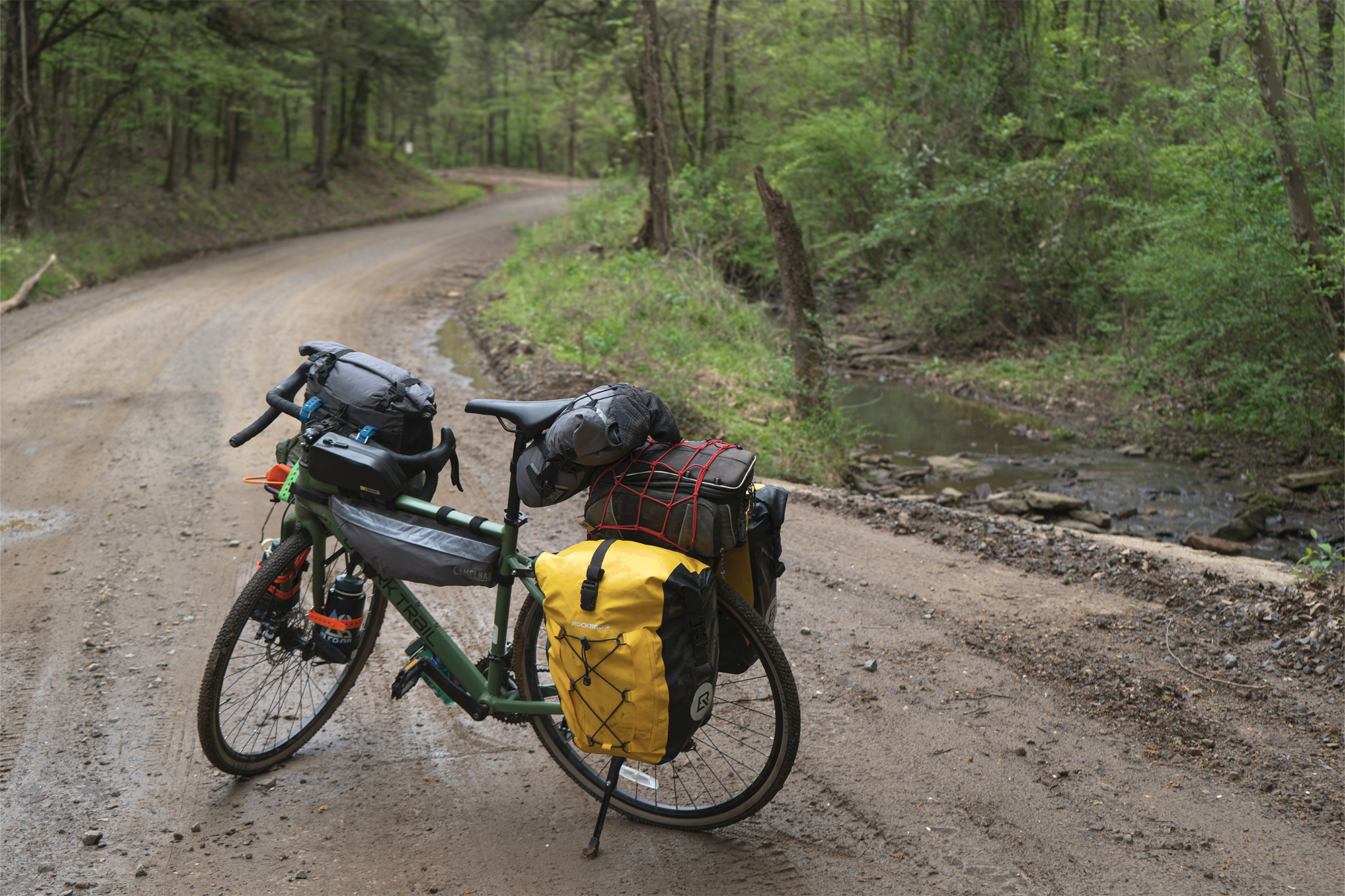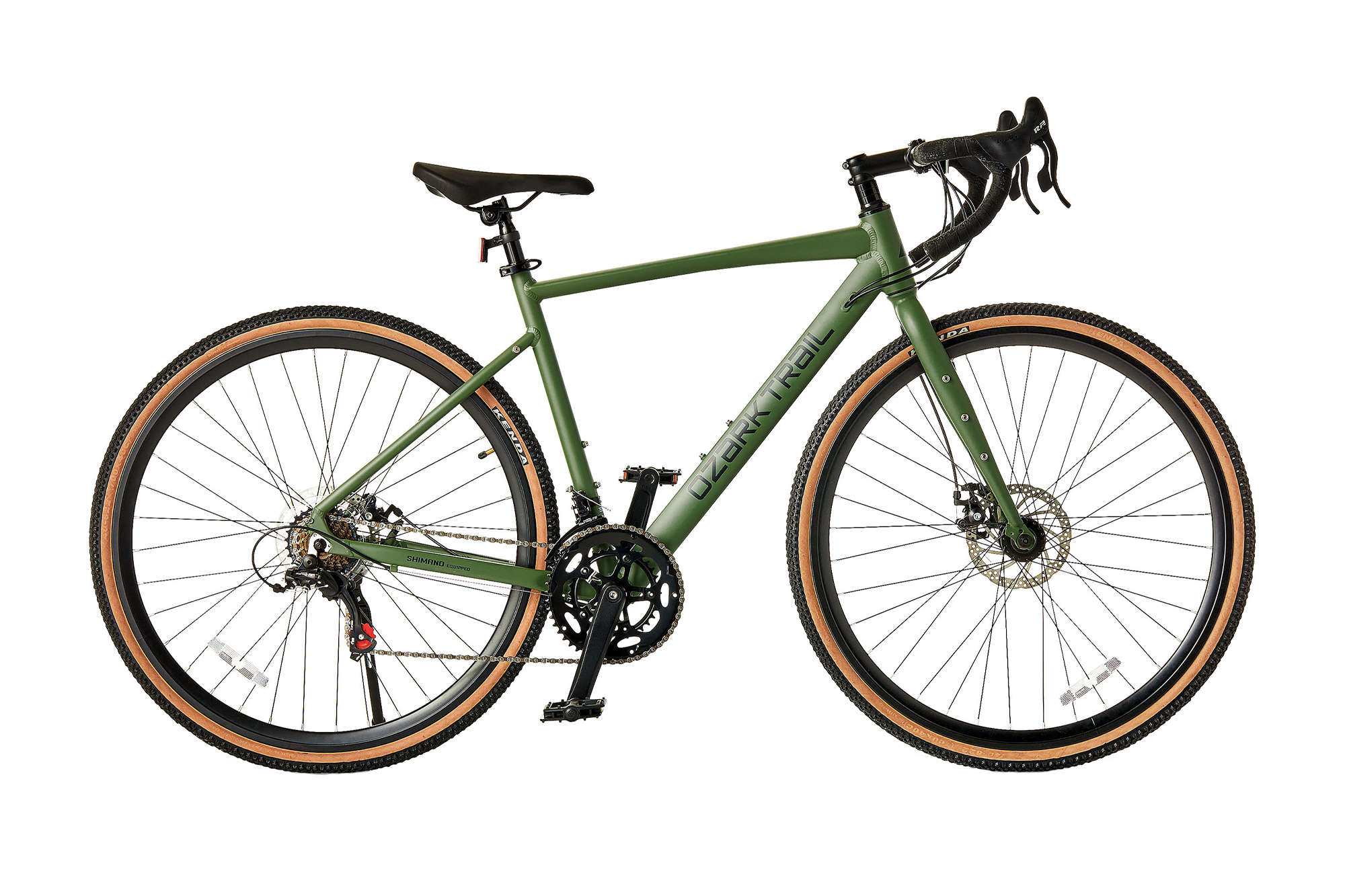I’ve been the guy adventuring on a threadbare budget. Whether because of a late payment, a stolen bike, a last-minute invitation, or otherwise, I’ve had to get creative. Now, one of the largest companies on earth is aiming to lower the gravel bike price barrier in a big way.
Last year, Walmart dropped a mountain under its Ozark Trails line, shocking many with the quality it boasted at a $400 price tag. But that’s par for the course.
Tom and Steuart Waltons, two brothers in the most branded family on earth, are cycling nuts. They and Walmart have done much to rebrand Bentonville, Ark., into the self-titled “Mountain Bike Capital of the World.”
Now, Walmart is rolling out its first-ever gravel bike, the Ozark Trail G.1 Explorer — a drop-bar 29-er with relatively generous mounting points for under $250. Bound for America’s most ubiquitous budget bike aisles, it could stir up the entry-level end of the adventure cycling market.
So, I did the only sensible thing: Days before they hit the aisles, I found myself standing outside a hotel with the new bike snagged from Walmart’s Bentonville headquarters less than 30 minutes away.
The mission: Cross the Ozarks, riding along hundreds of miles of new bikepacking routes mapped by the city of Fayetteville to lean into the cycling wave that nearby Bentonville and Walmart HQ have carved out. Riding to Little Rock, I’d test a new Ozark Trail along new Ozark Trails — finding some surprises along the way.
In short: Testing this bike nearly 300 miles from Walmart’s backyard to Arkansas’ capital, I found plenty of positives and negatives. The brakes were terrifying, and the drivetrain challenged me. But I loved the ample mounts; I’ve ridden much more expensive bikes without nearly as many. Most of all, the price made me wonder if the Ozark Trail G.1 will shake up the cycling industry.
- Weight: 30.4 lbs.
- Fork: Steel, quick release with mounts
- Frame: 6061 aluminum
- Sizes: Small and medium, 29” tires
- Drivetrain: L-TWOO 2×7, with Shimano Tourney rear derailleur
- Handlebar: Drop bar; 400mm top width with 15-degree flare
- Stock tires: Kenda 700x40c, soft gum sidewalls
- Stack: 560 mm (medium)
- Reach: 395 mm (medium)
- Wheelbase: 1,034 mm (medium)
- Fork geometry: 72-degree head tube; 63mm trail
Pros
- Budget-friendly price
- Front fork mounts
- Good general gravel riding geometry
- Appropriate handlebar flare
Cons
- Sketchy brakes
- Stiff shifting
- Heavy frame
- Flat-prone tires
Ozark Trail G.1 First Impressions
My first impression upon unloading the bike from a van: At least my torso is short. The medium Explorer I’d be spending the next 2 weeks with offered around 56 cm of stack: the height from the top of the head tube to the bottom bracket. For reach, the horizontal distance between the bottom bracket and the head tube, I was looking at around 40 cm.
At a hair under 6′ tall, with long arms and legs, I’m typically a large. Thankfully, with a short torso, I could rock this medium-sized bike for a few hundred miles. Surprisingly, Walmart only offers the Explorer in small and medium frames.
The bike’s mounting points also surprised me. I’ve ridden far more costly gravel, touring, or adventure riding-marketed bikes with fewer mounts. It’s a personal annoyance every time. Having three mounting points for water bottles on the bike’s triangle and front fork mounts for racks or cages made tossing my trusty Old Man Mountain Pizza and Divide racks possible.
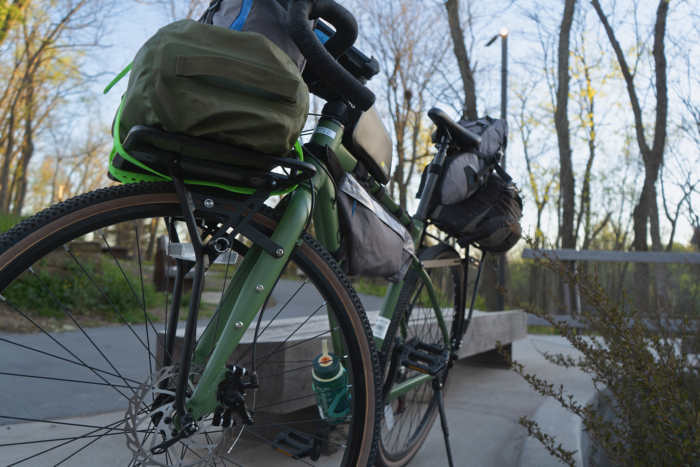
It also made economic sense, which aligns with the Walmart brand. Someone on a budget can get more mileage from pairing racks with dry bags, cheap panniers, used trunk bags, etc., that they already own than dropping the cash for trendier and more costly bikepacking bags.
My exact rack choice might not have been the cheapest. But going back to basics, I rigged them up with the oldest and most abused trunk bags and panniers I own.
Basics also seemed to be the approach to the Explorer’s geometry: The 72-degree head tube angle, roughly 44 mm of fork offset, the 440mm chainstay, and a wheelbase of around 1,035 mm — everything about the Ozark Trail G.1 Explorer seemed to be a case of classic gravel geometry. The drops of the handlebars seemed a bit deep but with 15 degrees of flare, it was not unreasonable.
First Ride
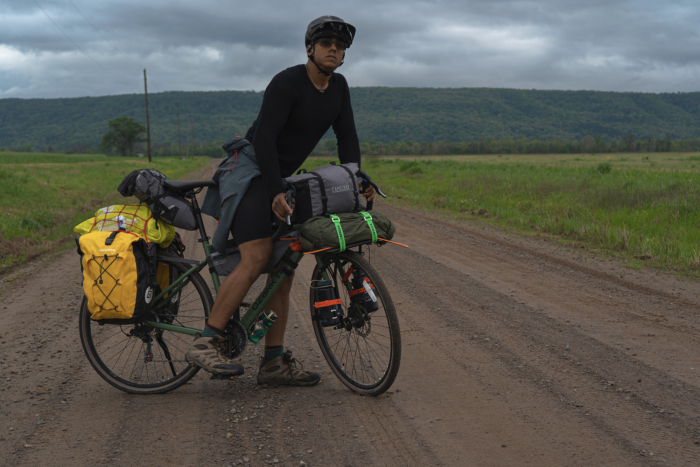
“I heard about that, but haven’t seen one yet,” said the mechanic at the Phat Tire down the street. “Better or worse, that bike is gonna shake things up for a lot of people.” With those words and extra inner tubes in my frame bag, I set off to put the Ozark Trail G.1 Explorer gravel bike through its first test.
Fayetteville is a bike town through and through. The paved 40-mile Razorback Greenway trail runs its length. Numerous other trails spin off, most mild, some dipping and hooking sharply into blind turns beneath bridges, and most busy with pedestrians. I’d have 3 days to sample them all before setting off into the Ozarks.
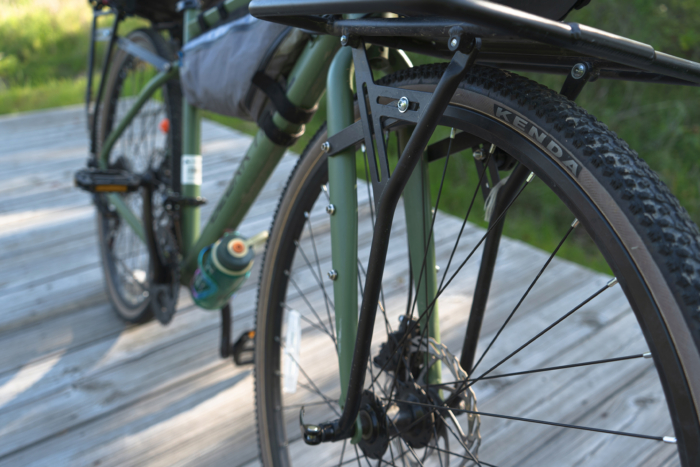
Apparently inspired by Kenda’s Booster Pros, the tires handled pavement commuting well. However, between myself, camera equipment, racks, bags, fishing gear, and more, I’d be pushing 265 pounds on the trail. The soft sidewalls would need extra pressure to keep from bottoming out on rough descents.
The shifting was stiff but surprisingly consistent. I could easily cruise up to 26 mph on flats and slight downhills. Uphill, the story was different.
The 2×7 L-TWOO drivetrain had a limited range. For general, entry-level consumers, prioritizing smooth shifting over range with budget hardware makes sense. But as I pushed this bike up the first steep paved hill I encountered, being passed along the way by pros heading off to the U.S. Mountain Bike Pro Cup, I saw more pushing in my future in the Ozarks.
One thing did worry me. I expected the brakes to need some fine-tuning. However, getting the brake to generate enough real stopping power without constant rubbing was difficult. Pushing 265 pounds, I could see tricky descents in my future.
Strep and Other Challenges

The first 2 days on the trail were going to be unfair. I’d be test-riding 50 miles of an unfinished bikepacking route up a mountain. That’s a tall order for a budget bike — especially when you come down with strep throat one day in.
The Explorer’s frame handled it well. Its slight flex was reasonable for how heavy I was riding. The front fork felt like a good compromise: slack enough for stability but steep enough that it didn’t feel sluggish with a week’s worth of food and a day’s water strapped to it.
The front cockpit was a give-and-take. The hoods were pretty comfortable. The drops were a bit deep for anything other than relatively smooth descents. On rough roads, though, I found myself wishing for wider bars. But that hardly topped my wish list.
Within those first 2 days, I found the brakes, drivetrain, and tires tapped out on steep ascents and descents that were 50% gravel and 50% golf-to-baseball-sized rocks. This terrain was well beyond the limits of these components.
The Explorer has the range for bikepacking through the mild hill country and unloaded rides through moderately steep terrain. But the approach to the Ozarks’ White Rock mountain wasn’t moderate. Feeling more sickly, I pushed the Explorer up a few miles of hills I’d ride up with most gravel bikes.
Two flats in as many days didn’t help the pushing. The Kenda tires would’ve been fun to ride on slightly more consistent and hard-packed gravel roads. However, with nearly 300 pounds of total weight on roads populated by jagged rocks, downhill runs meant bottoming out the tires, which meant pinch flats.
Starting the second day, things got scary when I braked on the descents. Between repairing flats, growing sicker, and running behind schedule for an eclipse viewing, I was short on time to fiddle and fine-tune the brakes. This is how I found myself still bombing down some descents at around 15 mph.
The Sweet Spot on the Ozark Trail G.1 Explorer
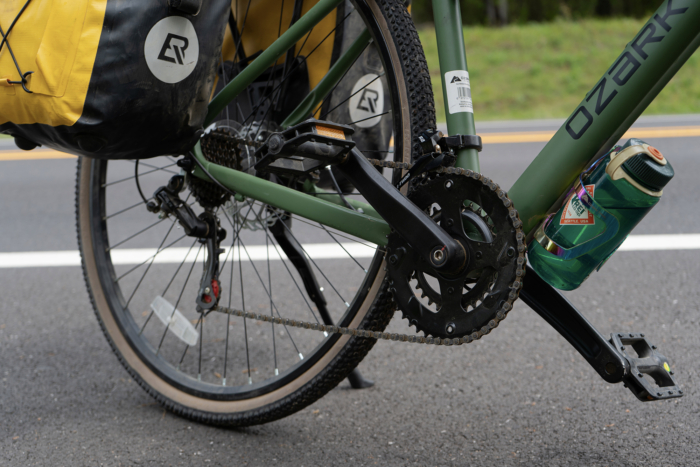
Plan B is where the Explorer shone. Growing weaker and running low on patches, I made a game call. The last 200 miles would detour along a mix of paved and harder-packed gravel roads closer to highways. Flats became a nonissue without larger jagged stones to bottom out the tires.
The drivetrain made sense on milder dirt, gravel, and paved roads. The pushing was over. Instead, the limited range of the gearing helped offset the shifting stiffness by making smaller jumps between gears.
After being ridden hard for around 125 miles, the brakes and front derailleur needed some time and attention with an Allen wrench to dial them back in. Once done, neither worked smoothly (and the former stayed rather noisy), but they were reliable.
I capped the grand adventure ride with 3 days of regular city commuting; the Explorer made for a relatively nimble ride about town.
Cost and Conclusions on the Ozark Trail G.1 Explorer
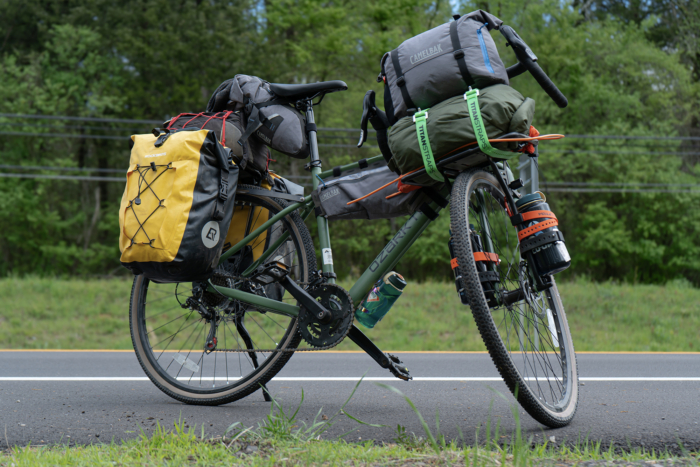
I’ve recalled my issues with the Ozark Trail G.1 Explorer. The bike’s shifting, braking, tires, and other attributes were annoying at times and at worst, frightening.
Yet, it carried 265 pounds of sickly human and gear through the Ozarks for less than $250. That’s a hell of an accomplishment.
Most of the shortcomings become less so with lighter loads and more moderate terrain. And yes, no matter what, some performance characteristics are only adequate for seasoned cyclists used to paying 10x or more for their gravel bikes. And yes again, the Ozark Trail G.1 Explorer is only available in two sizes.
Even so, for light adventurers, the Explorer is capable. It might be one of the most widely available gravel bikes. For whatever polish it might lack, the combination of availability, capability, and impressively low price (some handlebars and saddles cost more) make the Ozark Trail Explorer G.1 a genuine contender for adventurers on a budget — one bound to, like my mechanic said, “shake things up.”
